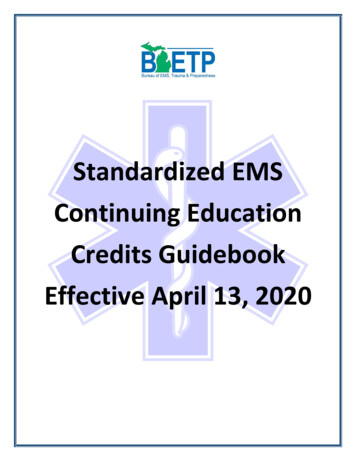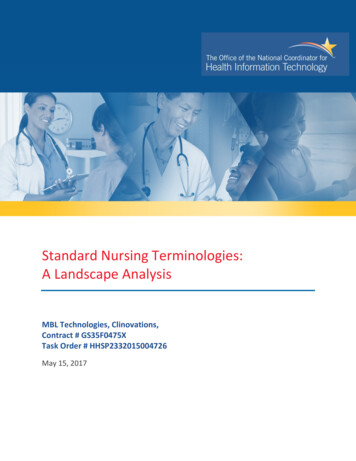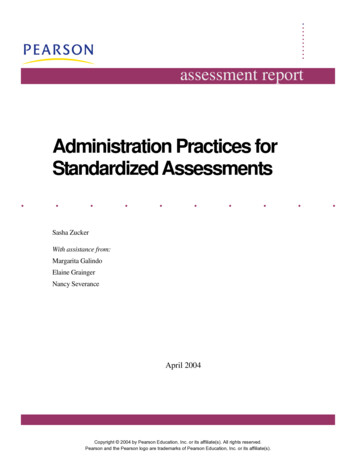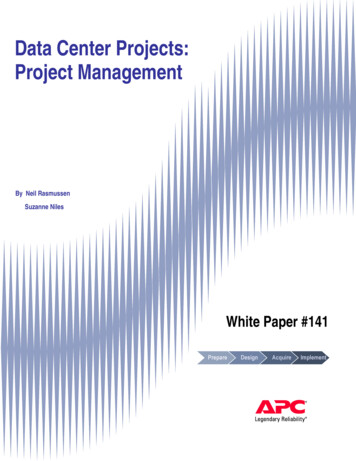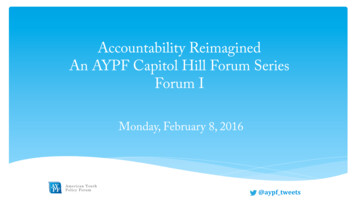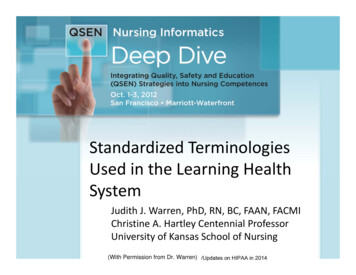
Transcription
Standardized TerminologiesUsed in the Learning HealthSystemJudith J. Warren, PhD, RN, BC, FAAN, FACMIChristine A. Hartley Centennial ProfessorUniversity of Kansas School of Nursing1(With Permission from Dr. Warren) /Updates on HIPAA in 2014
Standards Specified by Legislation HIPAA 1996– Code sets: ICD‐9 and moving to ICD‐10 in 2014, CPT, RxNorm,SNOMED CT, LOINC– Transactions: HL7, X12 MMA 2003– Confirmed HIPAA code sets– Transactions: HL7, X12, NCPDP HITECH of ARRA 2009– Confirmed HIPAA code sets, exploring ICF and other niche code sets(such as race, gender, etc.)– Confirmed transaction standards ACA 2011– Confirmed HIPAA code sets / Under the ACA, provisions to HIPAA further increase use of electronic datainterchange and include additional requirements– Confirmed transaction standards– Added Operating Rules for transactions3
4
Interface and Reference Terminologies Interface terminology supplies the terms used byclinicians as they talk about clinical concepts orthe set of terms displayed in an electronic healthrecord for the clinicians to use Theses terms need to be link/mapped to astandard reference terminology to achieve thebenefits of using standardized terminologies forinteroperability Examples of interface terminology: NANDA, localexpressions and preferences Examples of reference terminologies:ICD‐9‐CM,LOINC, SNOMED CT5
ICD‐9‐CM and ICD‐10‐CMWHO Collaborating Center for the Classification of Diseases forNorth America Established in 1974 at the National Center for Health Statistics(NCHS) WHO is a specialized agency of the United Nations Its responsibilities include the International Classification ofDiseases This is performed in conjunction with collaborating centers,established primarily on the basis of language, in North America(NCHS), England, Australia, Paris, Nordic countries, Moscow,Beijing, Caracas, Sao Paulo and Kuwait. Other countries, such asJapan, have recognized ICD offices6
ICD‐9‐CM and ICD‐10‐CM/ICD‐10‐PCS ICD‐9‐CM is a medical disease classification used inthe US as a billing classification http://www.cdc.gov/nchs/icd/icd9cm.htm In 2014 all healthcare services that receiveMedicare and Medicaid reimbursement will berequired to submit ICD‐10‐CM OR 1CD‐10‐PCScodes http://www.cdc.gov/nchs/icd/icd10cm.htm7
Current Procedural Terminology (CPT) IV and V Developed by the American html Adopted by CMS and most insurancecompanies as reimbursement codes8
RxNorm Developed by the National Library of Medicine to be a standardfor representing drug information in EHRs Provides normalized names for clinical drugs and links itsnames to many of the drug vocabularies commonly used inpharmacy management and drug interaction software,including those of First Databank, Micromedex, MediSpan,Gold Standard, and Multum. Mediates messages between systems not using the samesoftware and vocabulary. Includes the National Drug File ‐ Reference Terminology(NDF‐RT) from the Veterans Health Administration. Used to code clinical drug properties, including mechanismof action, physiologic effect, and therapeutic category. http://www.nlm.nih.gov/research/umls/rxnorm9
Systematic Nomenclature of Medicine—Clinical Terms (SNOMED CT) Developed and released by theInternational Health Terminology StandardsDevelopment Organization– http://www.ihtsdo.org/snomed‐ct Patient‐centric, Interprofessional clinicallyfocused terminology Developed to be used in EHRs for data entryand retrieval Optimized for clinical decision support anddata analysis USA has a free use license managed by theNational Library of Medicine10
The Axes of SNOMED CT—Provides theSyntax for the ConceptsClinical Finding Finding (Swelling of arm) Disease (Pneumonia)Procedure/intervention (Biopsy oflung)Observable entity (Tumor stage)Body structure (Structure ofthyroid)Organism (DNA virus)Substance (Gastric acid)Pharmaceutical/biologic product(aspirin)Specimen (Urine specimen)11Physical object (Suture needle)Physical force (Friction)Events (Disease outbreak)Environments/geographicallocations (Intensive care unit)Social context (Organ donor)Situation with explicit context(family history of heart disease)Staging and scales (Braden Scale)Attribute (Controlled temperature)Qualifier value (Bilateral)Linkage concept (has reason)
SNOMED CT Browser and Subsets CliniClue is a free browser that allows you to view SNOMED CT http://www.cliniclue.com/software There are several hundred thousand concepts in SNOMEDCT so a browser is necessary Problem list subsets for Meaningful Use Nursing problem ursingproblemlist subset.html Medical problem ore subset.html12
CliniClue Browser for SNOMED CT13
g problemlist subset.html14
IHTSDO Nursing Special Interest Group A community of practice for the nursing profession, supportingworldwide nursing participation in the development, validation,uptake, implementation, and correct use of SNOMED CT and relatedproducts. Participation is welcome from anyone interested in ensuring thatSNOMED CT supports nursing requirements for electronicdocumentation and communication of patient care in any setting Join the SIG: ‐groups Meets in person once a year at the annual meeting Meets monthly by webinar Information for attendance is posted at their web site above15
Logical Observation Identifiers Names andCodes (LOINC ) Developed by the Regenstrief Institute and supported by theNational Library of Medicine Provides a standard set of universal names and codes foridentifying individual laboratory and clinical results. Used in clinical observations and scales, e.g., Morse FallsRisk, Clinical Care Classification goals Nursing Consultant: Susan Matney, PhDc, RN, FAAN Chairs the Nursing SIG http://www.loinc.org16
Search functionality online; but also publishes a free ecial‐interest‐groups17
National Committee on Vital andHealth Statistics (NCVHS) Serves as the statutory public advisory body to theSecretary of Health and Human Services in the area ofhealth informationProvides advice and assistance to the DepartmentServes as a forum for interaction with interested privatesector groups on a variety of key health data issues Accelerates the evolution of public and privatehealth information systems Uniform shared data standardsProtecting privacy, confidentiality, and security Advises on implementation HIPAA, MMA, ACA18
Methods of Operation Meetings are open to public and broadcast onthe Internet www.ncvhs.hhs.gov Hears testimony on selected topics Testimony is invitedOpen microphone time at every hearing Sends letters of recommendation concerninghealth information technology to the Secretaryof the Department of Health and Human Services19
Office of the National Coordinator for HealthInformation Technology (ONC) NCVHS recommended to HHS that this office beestablished ONC is the major influencer in achieving the visionof the EHR and the Nationwide HealthInformation Network (NwHIN). Established by President Bush to support theadoption of healthcare IT in this country. Supported by President Obama and given a largerbudget in HITECH http://healthit.hhs.gov20
HIT Policy Committee: Advisory to ONCThe HIT Policy Committee will makerecommendations to the National Coordinator forHealth Information Technology on a policy framework for the development andadoption of a nationwide interoperable healthinformation infrastructure including standards for the secure and privateexchange of patient medical information ARRA 2009 requires recommendations on standards,implementation specifications, and certificationscriteria in eight specific areas. lementers/health‐it‐policy‐committee 21
HIT Standards Committee: Advisory to ONC Charged with making recommendations to the ONC on Standards Implementation specifications, and Certification criteria for the electronic exchange and use ofhealth information. Focus on the policies developed by the Health IT PolicyCommittee’s eight areas. While developing, harmonizing, or recognizing standards andimplementation specifications, the Health IT StandardsCommittee will also provide for the testing of the same by theNational Institute for Standards and Technology (NIST). lementers/health‐it‐standards‐committee22
Ways to Participate Dial into the meetings If there is an open microphone time, testify If feedback is requested, respond!!!!! Send in testimony you feel is pertinent and relevant Attend meetings in person, if possible, or by Internet Seek nomination to HIT Policy, HIT Standards, or their workgroups Support the Alliance for Nursing Informatics All nursing informatics organizations belong and they have aprocess for rapid turn‐around of testimony and comments http://www.allianceni.org23
Unified Medical Language System (UMLS)Rosetta Stone was critical to thetranslation between and amongancient languages UMLS functions in this capacity Developed by the NationalLibrary of Medicine Rosetta Stone24http://www.nlm.gov/research/umlsHas a metathesaurus that providesa crosswalk between concepts indifferent terminologies
Unified Medical Language System (UMLS)Developed by the National Library of Medicine http://www.nlm.gov/research/umlsA compilation of a number of classifications and codesetsHas a metathesaurus that provides a crosswalkbetween concepts in different systemsProvides support for Medline literature searchesIs NOT a clinical coded language25
Accurate Terminology Mapping Health Information Technology and HealthData Standards at NLM http://www.nlm.nih.gov/healthit.html http://www.nlm.nih.gov/research/umls Go to the web sites of the terminologies tolearn more Validate the terminology mappingUMLS26
Information System Architecture 27To realize the value of standardized terminologiesyou need Transaction and Message standards HL7, X12, NCPDP Terminology engine also known as aterminology server
Common Terminology Engine Allows for the definition of terms and relationships, whichcan then be used for the definition of clinical protocols,clinical applications, quality reporting and research Allows for transformation and abstraction of data Contains all the clinical concepts needed for healthcaredelivery, measurement, and research28
Architecture Framework for ClinicalInformation inistrativeSystemsClinical SystemsAnalytical DataRepositoryClinical DataRepositoryWorkflowEngineClinical Decision Support(Evidence Based Guidelines)Terminology Infrastructure( Data and Information))29RulesEngineTerminologyEngine
A Last Thought:Terminology is a TechnologyFor technology to work in health care so that itassists us in delivering quality care, the followingtechnologies must exist Hardware Software Messages Terminology that represents knowledge!30
Discussion Questions1. How does federal legislation impact standardized health careterminologies?2. Describe the role of LOINC and SNOMED in coding data for healthIT.3. How can you influence or participate in the activities of standarddevelopment and federal regulation?4. Give a brief description of each of the mandated code sets forHIPAA, MMA, HITECH and ACA. Why were they chosen?5. Why is the UMLS important?6. Describe a terminology engine and how terminologies areprocessed for the clinician to use.7. Why is terminology a technology?31
Teaching Methods and Strategies 32Lecture– Describe the process used to implement national terminologyrequirements: HIPAA, meaningful use, NCVHS, and ONC.Discussion Board– Use the questions from the previous slide.Journal– Have student keep a journal of where standardized terminologies areused when they are in clinical rotations.– Write reflections on their response to using and seeing used thevarious terminologies they learn about in class.Activity– Have students download the browsers and explore the terminologies;could be linked to a quality exercise by looking at the terminologyneeded for quality metrics.– Develop a slide presentation on one of the mandated terminologies.
Questions?33
Interface terminology supplies the terms used by clinicians as they talk about clinical concepts or the set of terms displayed in an electronic health record for the clinicians to use Theses terms need to be link/mapped to a standard reference terminology to achieve the




